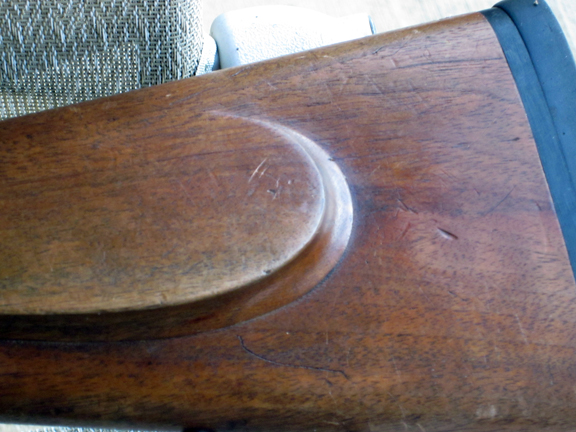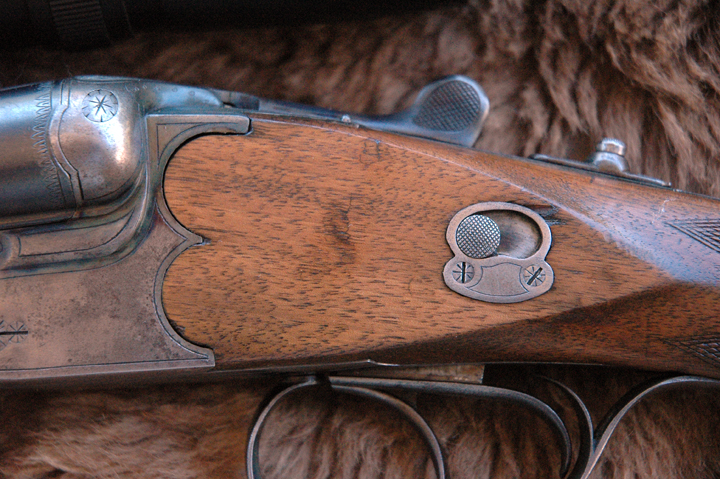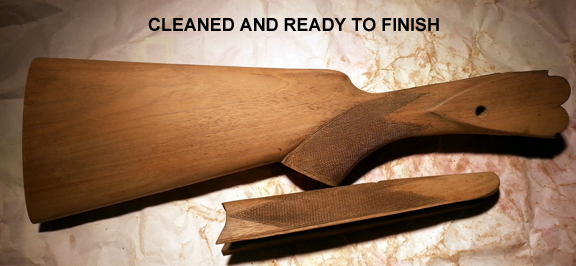

Long-time NRVO readers will probably be aware that some time ago I bought a lovely 1940-vintage drilling made by H. Burgsmüller und Sohne in Kreiensen Germany. This gun—like all the ones in the US dating from that period of time—was brought home by some GI as a souvenir. It had been around for 70+ years by the time I bought it from Cabela’s “Gun Library.” It has served me well in the US and in Africa, but in its long life it had taken some serious knocks here and there. While the metal finish was in okay shape and internally it was in perfectly functional condition, the wood had been pretty beaten up. No doubt that was one reason why it sold for a good bit less than some other drillings of the same era.
My experience with German sporting guns of the pre-WW2 period has shown me that without exception they’re phenomenally well made: even a no-maker’s-name so-called “guild” gun is fitted to a level of precision that couldn’t be duplicated today for any reasonable price. A drilling like mine, by a well-known second-tier maker like Burgsmüller really should have sold for a good bit more than I paid, and I was happy to get it.
I’m not one of those people who adheres to the theory that “originality” is the be-all and end-all of old guns. If a gun needs to be modified or updated, I’ll do it. I had had the stock shortened to fit me and discarded the original (worm eaten) horn buttplate; I also had a Leupold scope put on using quick-detachable mounts. These changes made it better suited to my size and hunting style.
After several years of sterling service with me, I felt the Burgsmüller had earned some tarting up. There wasn’t anything I could practically do about the barrels, because bluing a gun with three barrels that are soldered together is a job for a specialist. The people who do that sort of thing the right way (i.e., in the way that doesn’t cause the barrels to come apart) charge the earth for their services.
But the wood, now: that was a different matter. There were some really ugly dings, dents, and scratches that I felt could be dealt with by a good stock re-finisher. I decided to send the stock and fore-end off to John Lewandoski in Winchester, Virginia. John’s work doesn’t come cheaply but a look at the results shows he’s worth his hire.
The first priority was getting the stock and forend off the gun. Most break-action guns I’ve encountered use a through-bolt to hold the stock in place, but the Burgsmüller didn’t. I got enough of the action parts off to allow me to slide the stock back and forth a bit, but after that it was no go, and I didn’t know why. I took the receiver assembly to a local gunsmith: he had the proper screwdrivers to do the rest. The sort of skinny blades needed for the action screws on such guns are not found in a standard-issue set, even one made for amateur gunsmiths: but he was able to fabricate one with the correct blade thickness and taper to turn the Burgsmüller’s screws without the sort of damage an ordinary screwdriver would have caused.

The Burgsmüller has a “Blitz” action, a type in which the bottom plate carries the (fantastically complicated) lockwork. The plate is fitted to the body of the receiver so closely that you can’t really see a seam between them at all. But once the mounting screws had been removed the plate came out, carrying the guts of the action with it; and it was possible to remove the stock from the receiver intact.

A few pictures are shown to give an idea of how complicated this lockwork really is: three hammers (one for each barrel) a barrel selector lever, two triggers, and a safety catch, plus the lever to open the action by dropping the barrels.

I had thought that after the decades the action parts might need a thorough cleaning, but in fact the “box” is so tight that the steel was clean, fresh, and as good as the day the gun left Burgsmüller’s plant. All it got—or needed—was a thorough spray with WD-40 and a wipe-down before it was put in a box to await the return of the stock from John’s workshop.


Cheekpiece before and after


The checkering cleaned up


The major dings in the stock are no longer visible
He had said his process didn’t require sanding. I asked him to take pictures at various stages and these are shown, along with images of the completed work off and on the gun. John cleaned the wood and somehow removed the worst dings, visible in the image above.


The chip in the forend is gone
He polished off a gouge in the fore-end, freshened up the checkering (which had seven decades’ worth of sweat and dirt in between the diamonds) and applied a deep hand-rubbed oil finish.


The final results were outstanding, as the pictures show. Once the wood was returned I reassembled the gun and it’s ready for another 70 years in the field.
As mentioned above, there are those who would object to my having this work done, on the grounds that it “…will destroy the collector value.” Now, there is “refinishing” and there is “restoration,” the latter term denoting a return of the piece to its original condition. That’s the sort of thing Doug Turnbull does, and his prices for doing it are astronomically high. Even though it would take—well, it would take Doug Turnbull—to tell if a gun has been “restored” to his standards, collectors will pay far less for something that has been so restored. It’s inexplicable to me that a beaten-up, loose, out-of-time Colt Single Action Army with zero original finish is worth more to a collector of SAA’s than it would be had it gone through Turnbull’s shop and emerged as good as the day it first left Hartford. Which is really more valuable: a rusted relic suitable only as a wall hanger, or a gun, a real gun, that can be used as it was intended to be used?

There’s some truth in the “collector value” argument, but I counter it in this case with the knowledge that my drilling is NOT a collector’s gun, it’s a weapon for the hunter to use in the field. Not to use it would in some respects be insulting to the memory of the superb craftsmen who made it; furthermore it would void the real reason for its existence. It has no “provenance” to a famous person nor does it provide a physical connection to a major event in history. To stick it in a safe to gather dust would make little sense, when by the expenditure of a few dollars I can have it ready for the next-generation hunter who will follow me.

I can also give an example of a famous gun—connected to a famous person and a famous event—that has actually been through a restoration yet whose value is beyond calculation. The H&H double rifle Theodore Roosevelt took to Africa on his famous 1909 safari is priceless, but it was sent to H&H for restoration in 1989 due to “significant deterioration” of some parts. In that year it went to Africa where Theodore Roosevelt IV used it to take a Cape Buffalo just as his ancestor had done. Assuming some collector had the tens of millions of dollars it would take to buy TR’s gun (it is the most famous rifle in the world) would he spend more for it as it is now, or as it was before it underwent restoration? Having had the privilege of handling that double rifle I can tell you what my choice would be.
| HUNTING | GUNS | DOGS |
| FISHING & BOATING | TRIP REPORTS | MISCELLANEOUS ESSAYS |
| CONTRIBUTIONS FROM OTHER WRITERS|
| RECIPES |POLITICS |